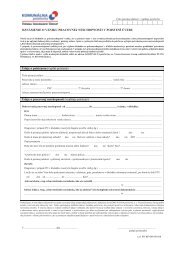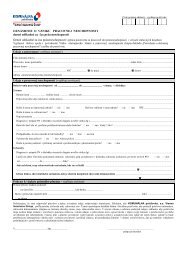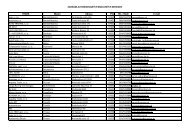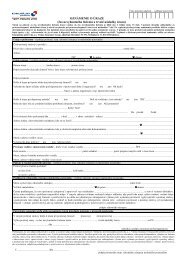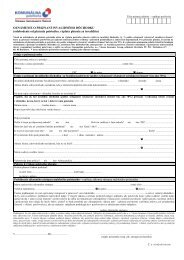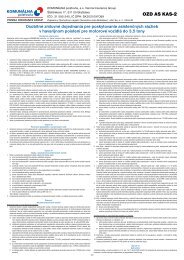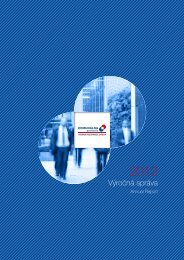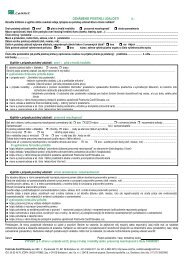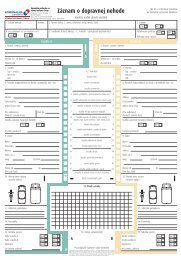(Všetky údaje su v tisícoch eur, pokiaľ nie je uvedené inak.)(ii)Menové rizikoSpoločnosť je vystavená menovému riziku, ktoré hlavne vzniká z pohybu výmenného kurzumeny Chorvátskej kuny (HRK). Spoločnosť všeobecne investuje do aktív denominovaných v týchmenách, v ktorých sú denominované aj záväzky a tým zmierňuje menové riziko vyplývajúce zcharakteru jej podnikania. Ako výsledok menové riziko vzniká z majetku (hlavne z cenných papierov)a záväzkov denominovaných v iných menách. Momentálne spoločnosťpredpokladá z cennýchpapierov denominovaných v HRK pri zmene HRK/EUR +/- 5% dopad na zisk a vlastnéimanie +/- 43 tis. Eur.Cenové rizikoCenové riziko je riziko, v dôsledku ktorého sa môže meniť reálna hodnota finančného majetkuz iného dôvodu ako je zmena úrokovej sadzby alebo meny. Spoločnosť je vystavená cenovémuriziku v dôsledku investície do majetkových cenných papierov, pričom riziko je ovplyvnené najmävývojom na akciových trhoch.Výsledky analýzy senzitivity vyjadrujú dopad na zisk a vlastné imanie Spoločnosti v prípadezmeny trhových cien majetkových cenných papierov. Celkový stav majetkových cenných papierovk 31. decembru <strong>2009</strong> predstavoval 20 956 tis. Eur (rok 2008: 0 tis. Eur). Pri poklese, resp. nárastetrhových cien o 10 %, by dopad na vlastné imanie predstavoval pokles, resp. nárast o 979 tis. Eur(rok 2008: 0 tis. Eur). Vplyv cenového rizika na zisk je nevýznamný pre majetkové cenné papierekryjúce investičné životné poistenie, nakoľko príslušné záväzky vyplývajúce z týchto zmlúv súovplyvnené v rovnakej miere.4.2.3 Úverové rizikoSpoločnosť je vystavená úverovému riziku, ktoré predstavuje riziko, že protistrana nebudeschopná uhradiť svoje záväzky v plnej výške, keď budú splatné. Hlavné oblasti, v ktorých je Spoločnosťvystavená úverovému riziku sú:<strong>Výročná</strong> <strong>správa</strong> <strong>2009</strong> I Annual Report <strong>2009</strong> KOMUNÁLNA poisťovňa a.s., Vienna Insurance Group• pohľadávky z poistenia voči poisteným,• pohľadávky zo zaistenia,• pohľadávky voči obchodným partnerom,• emitenti cenných papierov,• hotovosť• ostatné pohľadávkyZaistenie sa používa pri riadení poistného rizika. V konečnom dôsledku však neznižuje ručenieSpoločnosti ako primárneho poisťovateľa. Ak zaisťovateľ zlyhá pri plnení si svojich záväzkovz akýchkoľvek dôvodov, Spoločnosť zostáva zodpovedná za záväzky z poistenia. Spoločnosť prehodnocujeúverové riziko zaisťovateľov v spolupráci so svojim hlavným akcionárom.Na riadenie pohľadávok z poistenia voči poisteným používa Spoločnosť niekoľko nástrojov,jedným z nich je upomienkovací proces pohľadávok po splatnosti, ktorý prebieha v pravidelnýchintervaloch.V prípade jeho neúspešnosti prijíma Spoločnosť ďalšie opatrenia, pričom uplatňuje viacstupňovýproces vymáhania (intervenčná činnosť, súdne a exekučné vymáhanie). Okrem toho mesačnemonitoruje pohľadávky, pričom sleduje ich zaplatenosť a vekovú štruktúru. V závislosti na tomzisťuje riziko nezaplatenia pohľadávky, a znižuje hodnotu takýchto pohľadávok prostredníctvomtvorby opravnej položky, v zmysle IAS 39.Úverové riziko emitentov cenných papierov je riadené prostredníctvom investičnej stratégiea pravidiel. Tieto sú pravidelne prehodnocované v spolupráci s hlavným akcionárom Spoločnosti.150
(All amount are in thousands of Euros, unless stated otherwise)(ii)Currency riskThe Company is exposed to currency risk, mainly in respect to the Croatian kuna (HRK). Ingeneral, the Company invests in assets denominated in currencies in which the Company’s liabilitiesare denominated, thus mitigating the currency risk arising from the nature of its businessactivities. Currency risk arises mainly for securities and liabilities denominated in other currencies.If the Croatian kuna weakened or strengthened by 5% against the Euro, the Company is expectedto suffer a loss or generate a profit of EUR 43 thousand from securities denominated in Croatiankuna.(iii)Price riskThe price risk is the risk of a change in the fair value of financial instruments from movementsin market variables other than in interest rates and currency exchange rates. The Company isexposed to price risk due to its investment in equity securities. The risk is mainly exposure tomovements in prices of securities affected by market developments.The outcome of the sensitivity analysis shows an impact on the Company’s profit and ‘othercomprehensive income’ in changes in the market price of equity securities. At 31 December <strong>2009</strong>,equity securities totalled EUR 20,956 thousand (2008: EUR 0 thousand). If their market pricedecreased or increased by 10%, ‘other comprehensive income’ would be lower or higher by EUR979 thousand (2008: EUR 0 thousand). The impact of price risk on profit is not material for equitysecurities that cover investment life insurance, as the related liabilities arising from these contractsare affected in the same way.4.2.3 Credit riskThe Company has exposure to credit risk, which is the risk that a counterparty will be unableto pay amounts in full when due. Key areas where the Company is exposed to credit risk are:• amounts due from insurance contracts;• amounts due from reinsurance;• amounts due from intermediaries;• securities issuers;• balances in banks; and• other receivables.Reinsurance is used to manage insurance risk. This does not, however, discharge the Company’sliability as primary insurer. If a reinsurer fails to pay a claim for any reason, the Companyremains liable for the payment to the policyholder. The Company reviews the creditworthiness ofreinsurers in co-operation with its shareholder.The Company uses several tools to manage insurance receivables from the insured – one ofthem being the reminder process for overdue receivables that is carried out in regular intervals.If being unsuccessful, the Company takes other measures, using a several-stage collectionprocess (intervention activities, court settlement, and seizure). In addition, the Company monitorsreceivables on a monthly basis, by checking their payments and ageing structure. Based on this,the default risk is assessed and the value of impaired receivables is reduced by setting up animpairment provision in compliance with IAS 39.Credit risk of issuer of securities is managed through the investment strategy and rules, whichare regularly reassessed by the shareholders.Ročná účtovná závierka a komentár I Company Accounts151
- Page 3:
Výročná správaAnnual Report3
- Page 6 and 7:
Výročná správa 2009 I Annual Re
- Page 8 and 9:
1 Príhovor predsedu Dozornej radyV
- Page 10 and 11:
Výročná správa 2009 I Annual Re
- Page 12 and 13:
2 Úvod od predsedu predstavenstvaa
- Page 14 and 15:
Výročná správa 2009 I Annual Re
- Page 16 and 17:
3 O spoločnostiVýročná správa
- Page 18 and 19:
Obchodné meno:KOMUNÁLNA poisťov
- Page 20 and 21:
Základné imanie13 944 000 EURRozs
- Page 22 and 23:
Ing. Vladimír Bakešpredseda preds
- Page 24 and 25:
JUDr. Jozef Csákyčlen predstavens
- Page 26 and 27:
3.3. Vedenie spoločnostiRiaditelia
- Page 28 and 29:
3.4. Organizačná štruktúraValn
- Page 30 and 31:
Výročná správa 2009 I Annual Re
- Page 32 and 33:
4. Vienna Insurance GroupVýročná
- Page 34 and 35:
obchodu, čo sa odráža aj vo vyni
- Page 36 and 37:
Výročná správa 2009 I Annual Re
- Page 39:
5. Management ReportDear shareholde
- Page 42 and 43:
5.1. Ekonomické prostredie a poist
- Page 44 and 45:
5.2. Bilancia obchodného roku 2009
- Page 46 and 47:
Výročná správa 2009 I Annual Re
- Page 48 and 49:
poistenie výlučne pre poisťovňu
- Page 50 and 51:
Hlásené poistné udalosti za rok
- Page 52 and 53:
Graf č. 7: Podiel jednotlivých pr
- Page 54 and 55:
5.4. Zaistenie Komunálnej poisťov
- Page 56 and 57:
• Maximálna orientácia na záka
- Page 58 and 59:
Výročná správa 2009 I Annual Re
- Page 60 and 61:
Výročná správa 2009 I Annual Re
- Page 62 and 63:
Zavedenie personálneho controlling
- Page 64 and 65:
Vývoj počtu zamestnancov v hlavno
- Page 66 and 67:
nosti na predchádzajúce projekty
- Page 68 and 69:
5.10. Prevádzka poisteniaŤažisko
- Page 70 and 71:
5.12. Návrh na rozdelenie zisku za
- Page 73 and 74:
6Správa Dozornej radySupervisory B
- Page 75:
6 Supervisory Board reportof KOMUN
- Page 78 and 79:
Výročná správa 2009 I Annual Re
- Page 80 and 81:
Výročná správa 2009 I Annual Re
- Page 82 and 83:
KOMUNÁLNA poisťovňa, a.s. Vienna
- Page 84 and 85:
15.2 Dlhodobé poistné zmluvy- pre
- Page 88 and 89:
Súvaha(Všetky údaje su v tisíco
- Page 90 and 91:
VÝKAZ SÚHRNNÝCH ZISKOV A STRÁT(
- Page 92 and 93:
VÝKAZ ZMIEN VLASTNÉHO IMANIA(Vše
- Page 94 and 95:
VÝKAZ PEŇAŽNÝCH TOKOV(Všetky
- Page 96 and 97:
POZNÁMKY K ÚČTOVNEJ ZÁVIERKE(V
- Page 98 and 99:
(Všetky údaje su v tisícoch eur,
- Page 100 and 101: (Všetky údaje su v tisícoch eur,
- Page 102 and 103: (Všetky údaje su v tisícoch eur,
- Page 104 and 105: (Všetky údaje su v tisícoch eur,
- Page 106 and 107: (Všetky údaje su v tisícoch eur,
- Page 108 and 109: (Všetky údaje su v tisícoch eur,
- Page 110 and 111: pravidiel IFRS pri prvotnom prechod
- Page 112 and 113: (Všetky údaje su v tisícoch eur,
- Page 114 and 115: (Všetky údaje su v tisícoch eur,
- Page 116 and 117: (Všetky údaje su v tisícoch eur,
- Page 118 and 119: (Všetky údaje su v tisícoch eur,
- Page 120 and 121: (Všetky údaje su v tisícoch eur,
- Page 122 and 123: (Všetky údaje su v tisícoch eur,
- Page 124 and 125: (Všetky údaje su v tisícoch eur,
- Page 126 and 127: (Všetky údaje su v tisícoch eur,
- Page 128 and 129: (Všetky údaje su v tisícoch eur,
- Page 130 and 131: (Všetky údaje su v tisícoch eur,
- Page 132 and 133: (Všetky údaje su v tisícoch eur,
- Page 134 and 135: (Všetky údaje su v tisícoch eur,
- Page 136 and 137: (Všetky údaje su v tisícoch eur,
- Page 138 and 139: (Všetky údaje su v tisícoch eur,
- Page 140 and 141: (Všetky údaje su v tisícoch eur,
- Page 142 and 143: (Všetky údaje su v tisícoch eur,
- Page 144 and 145: (Všetky údaje su v tisícoch eur,
- Page 146 and 147: (Všetky údaje su v tisícoch eur,
- Page 148 and 149: (Všetky údaje su v tisícoch eur,
- Page 152 and 153: (Všetky údaje su v tisícoch eur,
- Page 154 and 155: (Všetky údaje su v tisícoch eur,
- Page 156 and 157: (Všetky údaje su v tisícoch eur,
- Page 158 and 159: (Všetky údaje su v tisícoch eur,
- Page 160 and 161: (Všetky údaje su v tisícoch eur,
- Page 162 and 163: (Všetky údaje su v tisícoch eur,
- Page 164: (Všetky údaje su v tisícoch eur,
- Page 167 and 168: (All amount are in thousands of Eur
- Page 169 and 170: (All amount are in thousands of Eur
- Page 171 and 172: (All amount are in thousands of Eur
- Page 173 and 174: (All amount are in thousands of Eur
- Page 175 and 176: (All amount are in thousands of Eur
- Page 177 and 178: (All amount are in thousands of Eur
- Page 179 and 180: (All amount are in thousands of Eur
- Page 181 and 182: (All amount are in thousands of Eur
- Page 183 and 184: (All amount are in thousands of Eur
- Page 185 and 186: (All amount are in thousands of Eur
- Page 187 and 188: (All amount are in thousands of Eur
- Page 189 and 190: (All amount are in thousands of Eur
- Page 191 and 192: (All amount are in thousands of Eur
- Page 193 and 194: (All amount are in thousands of Eur
- Page 195 and 196: (All amount are in thousands of Eur
- Page 197 and 198: (All amount are in thousands of Eur
- Page 199 and 200: (All amount are in thousands of Eur
- Page 201 and 202:
9AdresárDirectoryRočná účtovn
- Page 203 and 204:
Directory- branches, business outle
- Page 205 and 206:
Ročná účtovná závierka a kome



